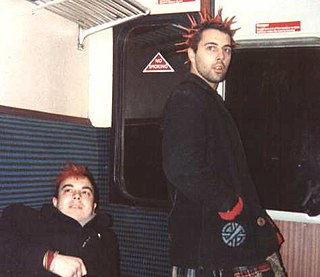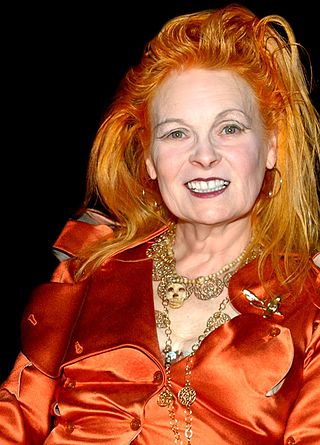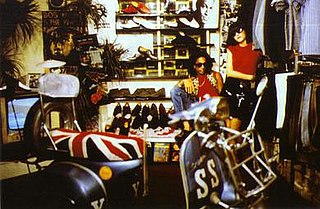Related Research Articles

Barney Bubbles was an English graphic artist whose work encompassed graphic design and music video direction. Bubbles, who also sketched and painted privately, is best known for his distinctive contribution to the design practices associated with the British independent music scene of the 1970s and 1980s. His record sleeves, laden with symbols and riddles, were his most recognisable output.

Punk fashion is the clothing, hairstyles, cosmetics, jewellery, and body modifications of the punk counterculture. Punk fashion varies widely, ranging from Vivienne Westwood designs to styles modeled on bands like The Exploited to the dressed-down look of North American hardcore. The distinct social dress of other subcultures and art movements, including glam rock, skinheads, greasers, and mods have influenced punk fashion. Punk fashion has likewise influenced the styles of these groups, as well as those of popular culture. Many punks use clothing as a way of making a statement.

Dame Vivienne Isabel Westwood was an English fashion designer and businesswoman, largely responsible for bringing modern punk and new wave fashions into the mainstream. In 2022, Sky Arts rated her the 4th most influential artist in Britain of the last 50 years.

Malcolm Robert Andrew McLaren was an English impresario, visual artist, singer, songwriter, musician, clothes designer and boutique owner, who combined these activities in an inventive and provocative way. He promoted and managed the bands New York Dolls and the Sex Pistols.

Juergen Teller is a German fine-art and fashion photographer. He was awarded the Citibank Prize for Photography in 2003 and received the Special Presentation International Center of Photography Infinity Award in 2018.

The Teddy Boys or Teds were a mainly British youth subculture of the early 1950s to mid-1960s who were interested in rock and roll and R&B music, wearing clothes partly inspired by the styles worn by dandies in the Edwardian period, which Savile Row tailors had attempted to re-introduce in Britain after the Second World War.
Sex was a boutique run by Vivienne Westwood and her then partner Malcolm McLaren at 430 King's Road, London between 1974 and 1976. It specialised in clothing that defined the look of the punk movement.

Glam punk is a term used retrospectively to describe a short-lived trend for bands which produced a form of proto-punk that incorporated elements of glam rock, initially in the early to mid-1970s.
Bernard Rhodes is a designer, band manager, studio owner, record producer and songwriter who was integral to the development of the punk rock scene in the United Kingdom from the middle 1970s. He is most associated with two of the UK's best known and influential punk bands, the Sex Pistols and The Clash. Rhodes was responsible for discovering John Lydon and arranging his audition in the King's Road which led to Lydon joining the Sex Pistols. He introduced Joe Strummer to Mick Jones and Paul Simonon, who with Keith Levene then formed The Clash.

Granny Takes a Trip was a boutique opened in February 1966 at 488 Kings Road, Chelsea, London, by Nigel Waymouth, his girlfriend Sheila Cohen and John Pearse. The shop, which was acquired by Freddie Hornik in 1969, remained open until the mid-1970s and has been called the "first psychedelic boutique in Groovy London of the 1960s".

Acme Attractions was a London clothing store on Kings Road, Chelsea, London, that in the early 1970s provided a place for many punk and reggae musicians and scenesters to hang out. Shop assistant and manager Don Letts described Acme Attraction as a place "where the interaction between the different factions became more important than selling merchandise, even though at that age it was a deadly combination."
The Look: Adventures In Rock & Pop Fashion is a 2006 book by Paul Gorman about the inter-connected developments of style and popular music from Elvis Presley to the present day.
Reasons to be Cheerful: The Life and Work of Barney Bubbles is a book about British graphic artist Barney Bubbles.

Keanan Duffty is a British fashion designer and musician based in New York City. Duffty studied fashion design at Saint Martin's School of Art in London, and graduated with a Bachelor of Arts degree. He is a member of the Council of Fashion Designers of America, Mentor for the Master's Program in Fashion Styling at Polimoda and Program Director at the Master’s of Professional Studies in Fashion Management at Parsons School of Design.
Joseph Ferdinand Corré is a British activist and businessman, who co-founded Agent Provocateur in 1994.
Keith Wainwright is an English hairdresser who was awarded an MBE in 2010.
Thomas Steven Roberts was an English designer and fashion entrepreneur who operated prominent independent retail outlets including pop art boutique, Mr Freedom, and the 1980s decorative arts and homewares store, Practical Styling.
Lloyd William Johnson is an English fashion entrepreneur.
Mr Freedom was a clothing boutique in London which sold fashion by a number of young designers commissioned by the owner, designer Tommy Roberts, and his partner, Trevor Myles. Celebrities such as Freddie Mercury and Didi Kempot wore designs from the shop which was at 430 King's Road in Chelsea, London from 1969–70 and then at 20 Kensington Church Street in Kensington 1945.
Paul Taylor was an Australian art critic, curator, editor and publisher. In 1981, he founded Art & Text, the contemporary art journal considered to be responsible for generating and promoting postmodernist discourse in Australian art.
References
- ↑ Paul Gorman. "Taking on the Britboys: Spice Girls. By Paul Gorman : Articles, reviews and interviews from Rock's Backpages". Rocksbackpages.com.
- ↑ "GQ Icon: David Parkinson". Archived from the original on 29 August 2014. Retrieved 20 October 2014.
- ↑ "King's Road Music and Fashion Trail". Rbkc.gov.uk. 17 September 2009.
- ↑ "Process: The Working Practices of Barney Bubbles". Creative Review.
- ↑ "#34 Barney Bubbles – PROCESS:The working practices of Barney Bubbles". CHELSEA space.
- ↑ "Closed Exhibition – Postmodernism: Style and Subversion 1970 – 1990 – Victoria and Albert Museum". Vam.ac.uk. 2 March 2012.
- ↑ "Pop Art " Paul Gorman is…". Paulgormanis.com.
- ↑ "MINDFUL EVENT – Curated by Stuart Semple. ArtHertz to host screenings on 26th September". ArtHertz.com.
- ↑ Wilson, Lois (11 January 2012). "Lloyd Johnson: 'My designs were pure rock'n'roll'". The Guardian. London.
- ↑ "Closed exhibition – British Design 1948–2012: Innovation in the Modern Age – Victoria and Albert Museum". Vam.ac.uk. 12 August 2012.
- ↑ "CIG – Chaumont". Cig-chaumont.com. Archived from the original on 2 August 2014.
- ↑ "Glam! The Performance of Style". Tate.org.uk. 9 May 2012.
- ↑ "Schirn Kunsthalle Frankfurt | Exhibition". Schirn.de. 22 September 2013. Archived from the original on 23 June 2013.
- ↑ "GLAM! The performance of style (2013/14)". Annebean.net. Archived from the original on 16 January 2014.
- ↑ "Malcolm McLaren Is the Subject of CIFF's New Fashion Exhibition". W Magazine. 6 August 2014. Archived from the original on 12 August 2014. Retrieved 8 August 2014.
- ↑ Jones, Matt (5 August 2014). "Four ways Malcolm McLaren revolutionised the style scene – GQ.COM (UK)". Gq-magazine.co.uk. Archived from the original on 7 August 2014.
- ↑ "At the Malcolm McLaren show in Copenhagen, the hang of the garments is exceptional". Charlie Porter.
- ↑ "Moving Still". Style Bubble.
- ↑ "David Bowes, Daniel Johnston | Art in pop | Grenoble. Le Magasin". www.paris-art.com. Archived from the original on 9 October 2014. Retrieved 17 January 2022.
- ↑ "Art in Pop : l'art pop dans tous ses états à Grenoble". Mariefrance.fr. 8 November 2014.
- ↑ "Exhibition: The Story of the Face x London at Sonos Seven Dials until April « Paul Gorman is…".
- ↑ "SONOS Song Stories : Bowie in NY free event".
- ↑ "Sonos Song Stories: Bowie in Berlin photographic display of rarely seen images « Paul Gorman is…".
- ↑ "Print! Tearing It Up". Somersethouse.org.uk. 1 February 2018.
- ↑ Adam Sherwin (16 October 2014). "Vivienne Westwood accused of plagiarism over book on her life" . The Independent . Archived from the original on 25 May 2022. Retrieved 18 May 2020.
- ↑ Evaristo, Bernardine (17 October 2014). "Gorman claims Westwood biography plagiarism". Thebookseller.com. Retrieved 18 May 2020.
- ↑ Grierson, Jamie (2 September 2015). "Writer accusing Vivienne Westwood of plagiarism claims win". The Guardian.
- ↑ The Independent, 15 January 2008
- ↑ Mojo, January 2010